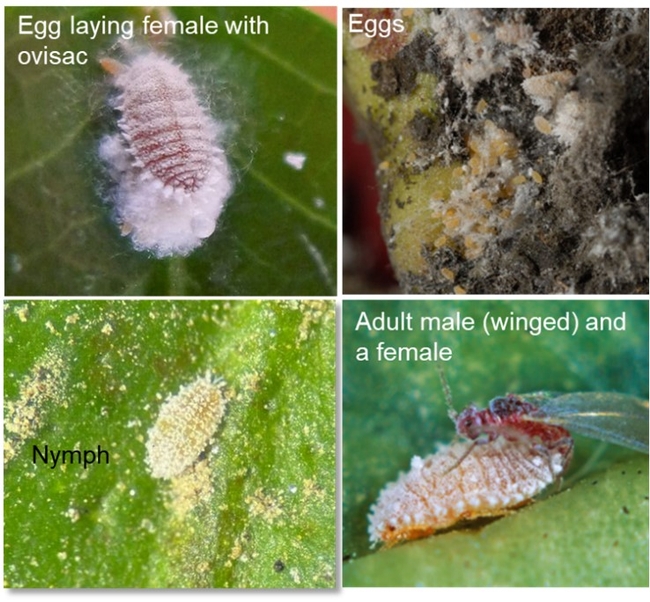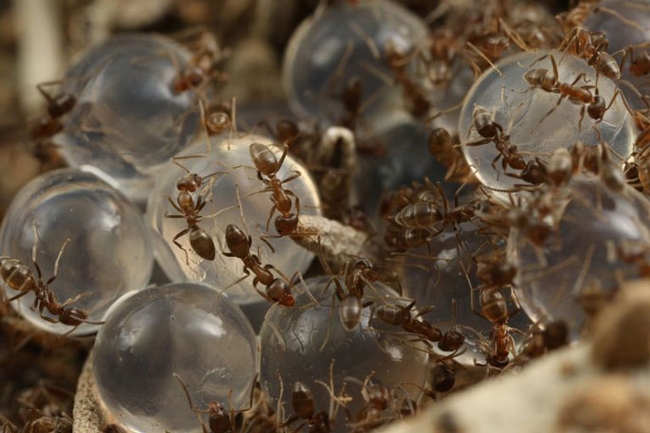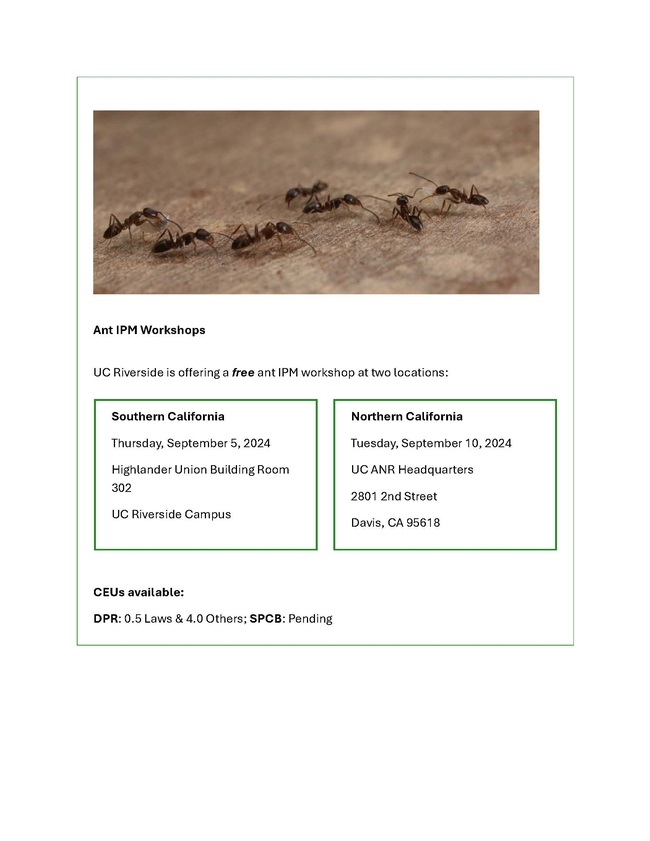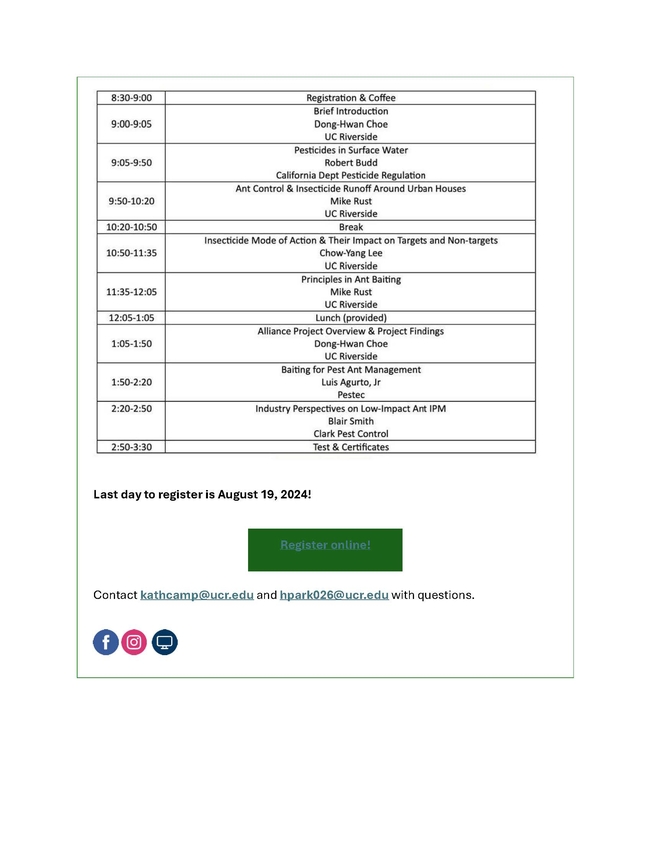Posts Tagged: ants
Free Ant Workshop - Come Marching In
In Person Ant IPM Workshops
Program for both workshops
|
Schedule
|
Speakers
|
Topics & Itinerary
|
|
8:00 AM – 8:15 AM
|
|
Arrival / Set-Up
|
|
8:30 AM – 9:00 AM
|
|
Registration & Coffee/Snacks
|
|
9:00 AM – 9:05 AM
|
Dong-Hwan Choe
|
Brief introduction
|
|
9:05 AM – 9:50 AM
|
Robert Budd
|
Pesticides in surface water
|
|
9:50 AM – 10:20 AM
|
Michael ?Rust
|
Ant control & Insecticide runoff around urban houses
|
|
10:20 AM – 10:50 AM
|
|
Break
|
|
10:50 AM – 11:35 AM
|
Chow-Yang Lee
|
Insecticide mode of action and their impact on targets and non-targets
|
|
11:35 AM – 12:05 PM
|
Michael Rust
|
Principles in ant baiting
|
|
12:05 PM – 1:05 PM
|
|
Lunch
|
|
1:05 PM – 1:50 PM
|
Dong-Hwan Choe
|
Alliance project overview and project findings
|
|
1:50 PM – 2:20 PM
|
Luis Agurto
|
Baiting for pest ant management
|
|
2:20 PM – 2:50 PM
|
Blair Smith
|
Industry perspectives on low-impact ant IPM
|
|
2:50 PM – 3:30 PM
|
|
Tests & Certificates
|
Lawn-pocalypse! Surviving Drought
Ah, summer! The season of sunburns, pool parties, and… lawn droughts. If your once lush, green carpet now looks like a crunchy brown doormat, you're not alone. Let's dive into why your yard is staging a dramatic death scene and what you can do to...

Bermuda grass and weeds overtaking drought stressed turf grass.
Ants and Mealybugs?
Managing citrus mealybug – does ant control help?
Sandipa Gautam, Sanjeev Dhungana, and David Haviland
UC Co-operative Extension
Starting 2019/20 season, pest control advisors started noticing citrus mealybug infestations in multiple citrus varieties that continued to increase in acreage in the San Joaquin Valley. Although present in the citrus systems, mealybugs were considered to be a minor pest and kept well under check by natural enemies until recently.
What are mealybugs?
Mealybugs are soft, oval, flat, distinctly segmented insects whose body is covered in white mealy wax. Citrus mealybug, Planococcus citri is the most common species associated with citrus. Females lay ~600 eggs in egg sacs loosely held by white cottony flint. Crawlers are yellowish, and can move or be carried by ants, birds, or the wind to start new infestations. Crawlers feed by sucking sap using straw-like stylets and soon develop a waxy covering (Fig. 1C). Like California red scale, females molt and stay as third instars until mated by a male. Males go through a pupal stage and emerge as adults with wings that fly to seek a mate.
Mealybugs prefer the inside canopy of the tree and can be found under dense leaves, between clusters of fruits, or in other cryptic places where they can be difficult to find, especially when the population is low. As the season progresses and the tree flushes, blooms, and fruit develops, mealybugs move to the parts of the tree where nutrients flow. Ongoing research on seasonal phenology suggest that there are 5-6 generations in the San Joaquin Valley. The first generation starts from overwintering adult/egg populations in late March/early April. The second-generation crawlers/nymphs move to fruit in June/July. The remaining generations each year primarily feed and multiply on the fruit.
Mealybugs produce nutrient rich honeydew that is an attractive food source for ants. Ants have been reported to defend insect colonies from predators and parasitoids. In an early infestation, ant trails can be used as an indicator to locate mealybug infestations or other sap sucking pests. Managing sugar feeding ants in citrus orchards has shown increased biocontrol of sap sucking insects. It is plausible that loss of chlorpyrifos as an ant control tool may have aggravated ants thereby aiding to increase mealybug pressure in recent years.
As mealybugs have become a reoccurring pest in citrus orchards, University of California researchers-initiated studies to work towards developing strategies to manage this pest. Research funded by Citrus Research Board and led by Gautam lab is investigating biology, field ecology, and management of mealybugs. During field visits, our observations have shown that various ant species of were present throughout the growing season attending mealybug colonies.
Does managing ant help suppress mealybug?
UC researchers have documented that managing sugar feeding ants increases biocontrol, thereby reducing the pest pressure of sap sucking insects. When ant densities are were reduced >90%, there was ~90% less mealybug on twigs and complete elimination of mealybug was reported from fruit. However, managing ants has been a challenge since the use of chlorpyrifos was banned. To address this need, UC researchers have worked to develop and test different types of hydrogel beads for delivering insecticide products to sugar-feeding species of ants.
Research led by David Haviland has focused on the experimental use of commercially-available polyacrylamide hydrogel beads for large field-scale applications. In 2023 a large-scale field trial was conducted in a 20-acre grapefruit block in Sanger, California. Two applications of hydrogel beads laced with insecticides were made on Aug 2 and August 30, 2023. Post-treatment evaluations for ant density were done on 24 trees/plot by counting the number of ants that passed through a graft union for 15 secs weekly for 4 weeks after each application. The effects of ant suppression on mealybug densities was evaluated in October 2023 by counting the number of fruits infested with mealybugs (presence/absence) on 30 fruits from the inside canopy. Insecticide treatments had variable results on ant density, with lowest ant density consistently found in plots treated with thiamethoxam. Similarly, plots treated with thiamethoxam had the lowest populations of mealybugs.
There's a lot more to this story:
https://ceventura.ucanr.edu/Com_Ag/Subtropical/?newsletteritem=100493

mealybug stages
Dealing with an Ant Invasion
It's that time of the year again – Ant Season! We often experience ants in our homes when weather conditions change. They are typically looking for food, water, warmth, and/or protection from extreme weather conditions. Ants belong to the...
Ants Come Marching In - UC IPM Citrus Update
UC IPM supports research and extension programs in integrated pest management (IPM). UC Agriculture and Natural Resources scientists adapt research for practical application, and Cooperative Extension advisors and specialists develop and deliver IPM programs to a variety of clientele, including professional pest managers, growers, residents, and agencies. UC IPM staff work with UC ANR scientists to develop "how-to" materials that help the clientele carry out programs and solve pest problems.
To complement the extension programs, UC IPM staff members coordinate development of a variety of materials that explain how to carry out pest management tactics and strategies. Working with UC ANR experts, program staff produce and maintain an extensive array of print and Web-based publications, databases, training materials, and interactive tools for decision making.
Examples are the pest management guidelines and a home and landscape database of pest solutions for residential audiences, IPM manuals for specific crops, books about IPM in landscapes and gardens, a variety of books on pesticide safety, and an extensive weather database that supports interactive pest models.
And now they are happy to announce the publication of a new update to the Citrus PMG. The Year-Round Program has been updated, Ants, Asian Citrus Psyllid, and Huanglongbing
And to learn more about Ant control in citrus, cherimoya and passion fruit, look into the upcoming workshops, September 19 and 21:
https://ucanr.edu/blogs/blogcore/postdetail.cfm?postnum=57442
https://ucanr.edu/blogs/blogcore/postdetail.cfm?postnum=57622

argentine ant and hydrogels



